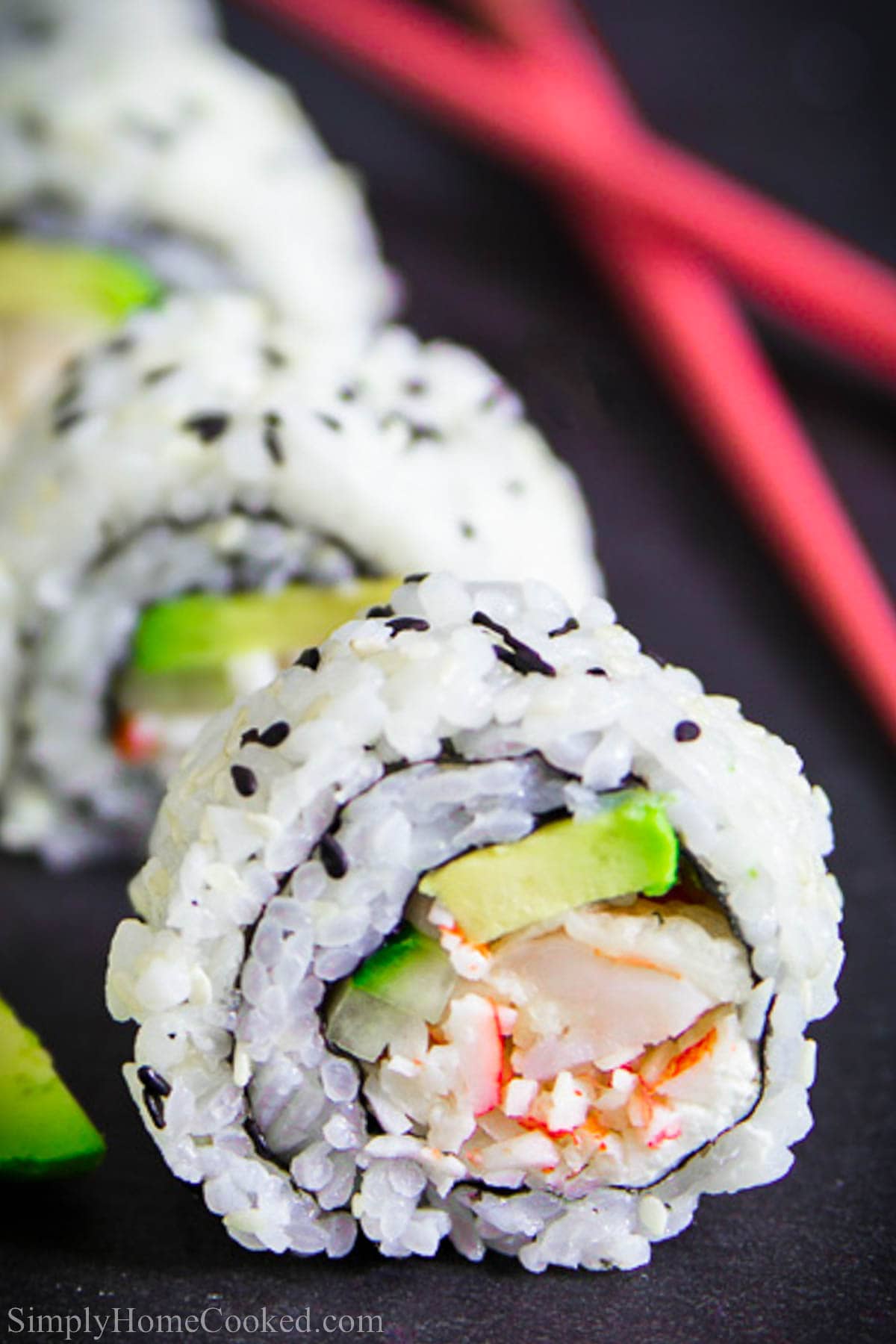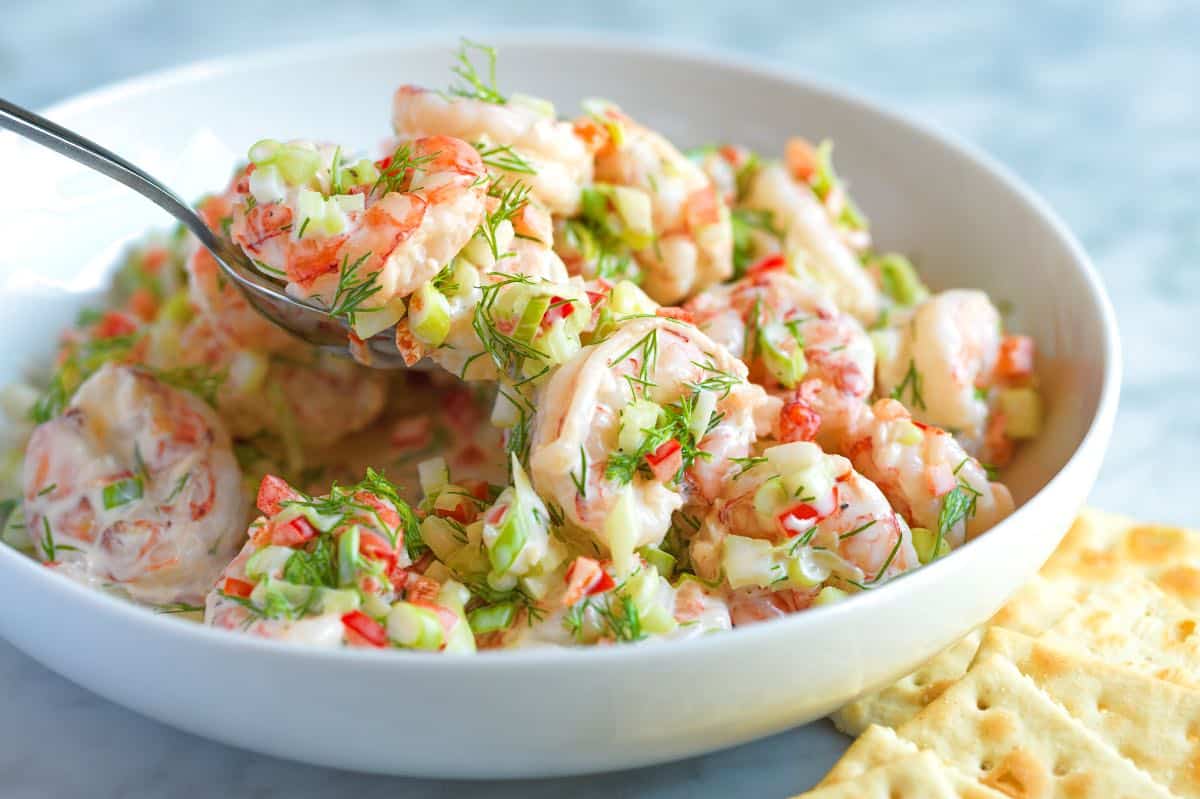If you like chicken lo mein or stir-fried shrimp recipes, like Chow Mei Fun, you’re going to love this easy shrimp lo mein recipe. This easy stir-fry noodle dish features succulent and juicy shrimp, slurp-worthy noodles, and crunchy vegetables coated in a le mein sauce.
Other Chinese recipes from our kitchen: Hunan Shrimp, Hunan Beef, Pan Wen San Vicky Chicken Udon.

what is lo mein
Translated as “stir-fried or tossed noodles” in Cantonese (lāo miàn 捞面), Lo Mein is a popular Asian stir-fry consisting of egg noodles, vegetables and a delicious sauce. This recipe for lo mein noodles is the perfect balance of flavors.
There are two variations of Lo Mein: Cantonese (Hong Kong style) and Americanized (Chinese Take Out style).
Having visited Hong Kong on several occasions, we quickly noticed that the Cantonese version of our favorites didn’t quite match up to the dishes we were used to in America. Although similar, there are some differences.

cantonese
The noodles and vegetables are served on a plate with the sauce on the side. When you are ready to enjoy, you pour the sauce on the dish yourself and mix.
Americanization
This is the popular version sold in American Chinese restaurants – noodles tossed with le mein sauce, vegetables and sometimes protein.
Lo Mein vs. Chao Mein
The difference between chow mein and low mein comes down to the noodles! While lo mein noodles are thicker and chewy, chow mein noodles are crispier and thinner.
When it comes to the cooking method, Lu Mein noodles are usually steamed or boiled while Chow Mein noodles are usually stir-fried.
Component:
Here are the “untrustworthy” ingredients required and recommended to make this easy lo mein recipe. For the full ingredient list, see the recipe card below.
Lo Mein Noodles (Chinese egg noodles)
shrimp – Use medium-sized raw, peeled and deveined shrimp with tails removed.
vegetables – Pick and choose from your favorite vegetables.
dark soy sauce – This is a Chinese staple for the pantry. It is less salty and a little sweeter than regular soy sauce.
Hoisin sauce – Asian style barbecue sauce adds lots of umami flavor.
Oyster sauce – If you don’t have oyster sauce, replace it with fish sauce, a little soy sauce and a little extra sugar.
For extra texture and added flavor, top the bowls with crunchy chow mein noodles or even nuts.
How to make lo-mein
Lo Mein Shrimp requires about 20 minutes total to prepare; Half cooking time and half preparation time. When preparing stir-fries, it is very important to prepare all the ingredients in advance (mis en place).
For the full recipe, see the detailed recipe card below.
sauce – Whisk together the sauce ingredients.
noodles – Cook the noodles (time varies by type – see recipe card).
Shrimp – Sear the shrimp.
vegetables – Saute the aromatics and vegetables (harder vegetables go in first).
Sauteed – Add the noodles, shrimp and sauce to the wok and toss! Top with green onions and serve with the addition of egg drop soup.
Blackstone Stir Fry
To prepare on the Blackstone, preheat the pan to high heat. Follow the recipe as written, but add the sauce last when everything else is cooked and mixed.
Tip: If you have a large blackstone, keep one of the end burners on so you can just slide the seared shrimp on top while you cook the other ingredients.
Check out our other Blackstone recipes.
Stir-fried noodles
You have three types of noodles to choose from when preparing: pre-cooked fresh lo mein noodles, uncooked fresh lo mein noodles and dried lo mein noodles. You will find these noodles in the Asian market in the fresh noodles in the corner of the refrigerator.
Fresh noodles
The best noodles to use are fresh lo mein noodles – all they require is a quick rinse in hot water. If the fresh halo mein noodles are not cooked, boil them for 2 minutes, until barely al dente.

Uncooked noodles
Cook dried Le Mein noodles according to the instructions on the back of the package – just set the timer to one minute less than the “al dente” time provided. If they start to stick, rinse them quickly in hot water and drain before tossing them into the pan.
other options
Substitutes include udon, buccini, spaghetti, linguini, or even fettuccine noodles. Cook according to the instructions on the back of the box – just cook one minute less than the “al dente” time provided.
Here’s a quick guide on the differences Chinese noodles.
Lo Mein sauce
The secret to authentic Lo Mein shrimp lies in its salty sauce. A well-balanced combination of soy sauce, sesame oil and a touch of sugar, our Le Mein sauce recipe will give your dish the distinct taste found in Chinese restaurants.
Le Mein sauce will have a salty taste when tasted on its own, but the overall saltiness will diminish once the “not so salty” noodles and vegetables are added.

Roasted Vegetables
The beauty of stir-fried shrimp with noodles lies in its fresh ingredients and adaptability. Just like you can when making Pad Woon Sen, you can easily add or substitute ingredients according to your preference and what you have on hand. Just be sure to choose vegetables with a variety of textures.
Here are 11 vegetables that can go into a shrimp lo mein dish:
- Snow peas
- snap peas
- broccoli
- carrots
- Dwarf corn
- mushrooms
- Bok choi
- bean sprouts
- Bamboo shoots
- Onion
- Water chestnuts
When cooking, keep in mind that different vegetables take longer to cook. Hard vegetables (think carrots, peppers) should be added to the pan first while soft vegetables (bok choy, bean sprouts) will arrive about 2 minutes later.
Variations
sharp
If you are into spices, add red pepper flakes, sriracha, red peppers, chili oil or even chili sauce to the sauce.
Lo Mein seafood
Add a total of 8 ounces of your favorite seafood! Oysters and octopus would be great additions, although not authentic.
chicken
To make with chicken, visit our detailed Chicken Lo Mein recipe.

Beef
To make beef, use 8 ounces of thinly sliced beef in place of the shrimp.
vegetarian
Omit the protein (or use tofu) and add more vegetables. Be sure to use some crunchy vegetables to ensure texture.
Expert advice
- No need for a wok! Just use a large pan – preferably one with high edges.
- For even cooking, cut the vegetables into similar sizes.
- Cook the noodles a little because they will continue to cook when they are added to the pan. In addition, it is likely that they will stick together when frying.
- The oil should be hot (a little bubbly) before adding the food.
- Lo Mein Shrimp is best when enjoyed immediately.
- Keep leftovers in an airtight container and store in the refrigerator for up to 3 days.
More Asian recipes
Korean beef bulgogi
Honey nut shrimp
Pairings for drinking
Be sure to have Sauvignon Blanc or Gruner and Talliner when serving Shrimp Lo Mein.
Calories: 513KKL
cost: $15
Cook the noodles:
-
If using freshly cooked noodles – Rinse quickly in hot water to remove the noodles. set aside.If using fresh, uncooked noodles – Boil for 2 minutes, until barely al dente.If using dry noodles – Cook according to the instructions on the back of the box – just set the timer for one minute less than the “al dente” time provided.
Cook the shrimp:
-
Add 1 tablespoon of oil to a wok or large pan and preheat on high heat.
2 tablespoons of vegetable or avocado oil, divided
-
Add the shrimp to the very hot pan (make sure there are no overlapping pieces) and sear for 15 seconds on each side. Remove from the pan and set aside (the inside will not be fully cooked yet).
8 ounces medium shrimp, peeled, deveined and tails removed
-
Add 1 tablespoon of oil to the pan. Add the garlic and ginger. Stir fry for 30 seconds, until fragrant.
1 teaspoon fresh ginger, grated
2 garlic cloves, chopped
-
Add the pepper, carrot and snow peas to the pan and stir-fry for 2 minutes.
½ red pepper, thinly sliced
1 medium carrot (julienne)
½ cup snow peas
-
Add the cabbage and stir-fry for 30-60 seconds, or until it softens.
2 cups thinly sliced green cabbage
-
Add the noodles to the pan and stir-fry for a minute, until they combine well.
-
Add the sauce to the pan and stir-fry for a minute until the sauce is hot and everything is evenly coated.
-
Add the shrimp to the pan and stir-fry for another 1-2 minutes, until the shrimp is cooked all the way through.
-
Top with sesame and green onion and enjoy.
Garnish: sesame and green onion
- 4 ounces dry egg noodles
- 4 oz dry linguine/spaghetti/udon noodles
If you’re having trouble with the egg noodles sticking, add about 1/4 cup of water to the noodles to help loosen them before adding to the pan.
Note 2 – Use medium-sized raw shrimp (peeled and without veins) for best results.
Note 3 – Add the hard vegetables, which take longer to cook, to the pan first.
Note 4 – Replace with regular low sodium soy sauce especially if you don’t have dark soy sauce. The dark soy sauce is what gives the noodles the darker color.
Note 5 – Replace the oyster sauce with equal parts hoisin sauce, if you don’t have it on hand.
Calories: 513KKL | Carbohydrates: 67G | protein: 29G | Fat: 15G | Saturated fat: 2G | Polyunsaturated fat: 3G | Unsaturated fat: 8G | trans fat: 0.1G | Cholesterol: 185mg | sodium: 1015mg | potassium: 684mg | fiber: 5G | Sugar: 8G | vitamin: 4289IU | Vitamin C: 54mg | calcium: 121mg | iron: 3mg








